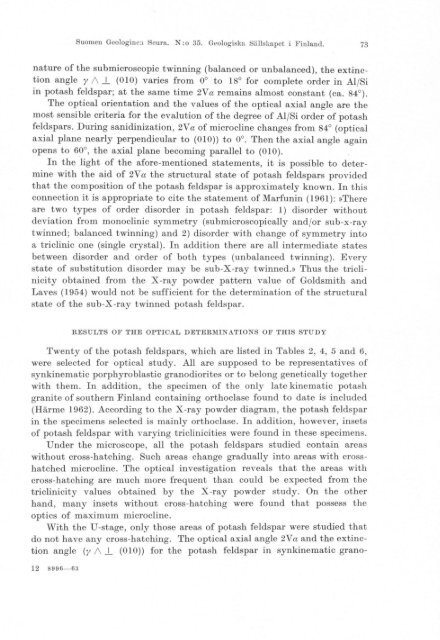COMMISSION GEOLOGIOUE - Arkisto.gsf.fi
COMMISSION GEOLOGIOUE - Arkisto.gsf.fi
COMMISSION GEOLOGIOUE - Arkisto.gsf.fi
You also want an ePaper? Increase the reach of your titles
YUMPU automatically turns print PDFs into web optimized ePapers that Google loves.
Suomen Geologinc:l Seura. N: 0 35. Geologiska Sällskapet i Finland. 73<br />
nature of the submicroscopic twinning (balanced or unbalanced), the extinction<br />
angle y /\ ...L (010) varies from 0° to 18° for complete order in Al/Si<br />
in potash feldspar; at the same time 2Va remains almost constant (ca. 84°).<br />
The optical orientation and the values of the optical axial angle are the<br />
most sensible criteria for the evalution of the degree of Al/Si order of potash<br />
feldspars. During sanidinization, 2Va of microcline changes from 84° (optical<br />
axial plane nearly perpendicular to (010)) to 0°. Then the axial angle again<br />
opens to 60°, the axial plane becoming parallel to (010).<br />
In the light of the afore-mentioned statements, it is possible to determine<br />
with the aid of 2Va the structural state of potash feldspars provided<br />
that the composition of the potash feldspar is approximately known. In this<br />
connection it is appropriate to cite the statement of Marfunin (1961): »There<br />
are two types of order disorder in potash feldspar: 1) disorder without<br />
deviation from monoclinic symmetry (submicroscopically and/or sub-x-ray<br />
twinned; balanced twinning) and 2) disorder with change of symmetry into<br />
a triclinic one (single crystal). In addition there are all intermediate states<br />
between disorder and order of both types (unbalanced twinning). Every<br />
state of substitution disorder may be sub-X-ray twinned.» Thus the triclini<br />
city obtained from the X-ray powder pattern value of Goldsmith and<br />
Laves (1954) would not be suf<strong>fi</strong>cient for the determination of the structural<br />
state of the sub-X-ray twinned potash feldspar.<br />
RESULTS OF THE OPTICAL DETERMINATIONS OF THIS STUDY<br />
Twenty of the potash feldspars, which are listed in Tables 2, 4, 5 and 6,<br />
were selected for optical study. All are supposed to be representatives of<br />
synkinematic porphyroblastic granodiorites or to belong genetically together<br />
with them. In addition, the specimen of the only late kinematic potash<br />
granite of southern Finland containing orthoclase found to date is included<br />
(Härme 1962). According to the X-ray powder diagram, the potash feldspar<br />
in the specimens selected is mainly orthoclase. In addition, however, in sets<br />
of potash feldspar with varying triclinicities were found in these specimens.<br />
Under the microscope, all the potash feldspars studied contain areas<br />
without cross-hatching. Such areas change gradually into areas with crosshatched<br />
microcline. The optical investigation reveals that the areas with<br />
cross-hatching are much more frequent than could be expected from the<br />
triclinicity values obtained by the X-ray powder study. On the other<br />
hand, many insets without cross-hatching were found that possess the<br />
optics of maximum microcline.<br />
With the U -stage, only those areas of potash feldspar were studied that<br />
do not have any cross-hatching. The optical axial angle 2Va and the extinction<br />
angle (y /\ ...L (010)) for the potash feldspar in synkinematic grano-<br />
12 8996-63
















